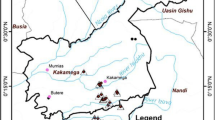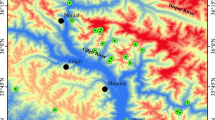Abstract
The study of gold sites in the Migori Gold Belt, Kenya, revealed that the concentrations of heavy metals, mainly Hg, Pb and As are above acceptable levels. Tailings at the panning sites recorded values of 6.5–510 mg kg−1 Pb, 0.06–76.0 mg kg−1 As and 0.46–1920 mg kg−1 Hg. Stream sediments had values of 3.0–11075 mg kg−1 Pb, 0.014–1.87 mg kg−1 As and 0.28–348 mg kg−1 Hg. The highest metal contamination was recorded in sediments from the Macalder stream (11075 mg kg−1 Pb), Nairobi mine tailings (76.0 mg kg−1 As) and Mickey tailings (1920 mg kg−1 Hg). Mercury has a long residence time in the environment and this makes its emissions from artisan mining a threat to health. Inhaling large amounts of siliceous dust, careless handling of mercury during gold panning and Au/Hg amalgam processing, existence of water logged pits and trenches; and large number of miners sharing poor quality air in the mines are the major causes of health hazards among miners. The amount of mercury used by miners for gold amalgamation during peak mining periods varies from 150 to 200 kg per month. Out of this, about 40% are lost during panning and 60% lost during heating Au/Hg amalgam. The use of pressure burners to weaken the reef is a deadly mining procedure as hot particles of Pb, As and other sulphide minerals burn the body. Burns become septic. This, apparently, leads to death within 2–3 years. On-site training of miners on safe mining practices met with enthusiasm and acceptance. The use of dust masks, air filters and heavy chemical gloves during mining and mineral processing were readily accepted. Miners were thus advised to purchase such protective gear, and to continue using them for the sake of their health. The miners' workshop, which was held at the end of the project is likely to bear fruit. The Migori District Commissioner and other Government officials, including medical officers attended this workshop. As a result of this, the Government is seriously considering setting up a clinic at Masara, which is one of the mining centres in the district. This would improve the health of the mining community.
Similar content being viewed by others
References
Agency for Toxic Substances and Disease Registry, US Public Health Service (ATSDR): 1993, Lead.
Agency for Toxic Substances and Disease Registry, US Public Health Service (ATSDR): 1999, Top 20 Hazardous Substances: ATSDR/EPA Priority List for 1999.
Allum, A.F.: 1951, Geological Mapping of the Macalder Workings, Mine Records, Macalder Mine, Kenya.
Cohen, R.R.H.: 2000, Impacts of Mining on the Environment: Acid Drainage Treatment and Rehabilitation, Lecture Notes.
Harada, M.: 1996, Characteristics of industrial poisoning and environmental contamination in developing countries, Environmental Sciences MY, Tokyo, 4(Suppl), 157–169.
Harada, M.: 1997, Neurotoxicity of Methyl-mercury: Minamata and the Amazon, in: M. Yasui, M.J. Strong, K. Ota and M.A. Verity (eds), Mineral and Metal Neurotoxicology, CRC Press, Tokyo, pp. 177–188.
Harada, M., Nakachi, S., Cheu, T., Hamada, H., Ono, Y., Tsuda, T., Yanagida, K., Kizuki, T. and Ohno, T.H.: 1997, Mercury Pollution in Tanzania: Relation Between Scalp Hair, Mercury Level and Health, Institute of Molecular Embryology and Genetics, Kumamoto, Japan, 14 pp.
Hutchinson, R.W.: 1981, Report on UNRFNRE Exploration Project, Migori Gold Belt, Kenya, 22 pp.
Keays, R.R.: 1982, Archaean gold deposits and their source rocks. The Upper Mantle Connection, in: Proceedings of the Symposium ‘Gold 82’, Zimbabwe, pp. 17–51.
Kuehn, S., Ogola, J.S. and Sango, P.: 1990, Regional Setting and Nature of Gold Mineralisation in Tanzania and Southern Kenya, Vol. 46, Elsevier Science Publishers, B. V. Amsterdam Precamb. Research, pp. 71–82.
Minamata Disease Museum: 1993, Minimata Disease, Foundation Minamata Disease Centre Soshisha, Minimata, 168 pp.
Minimata Disease Municipal Museum: 1997, Ten Things to Know About Minimata Disease, Publ. The Minimata Environmental Creation Development Project Steering Committee, Minamata, 12 pp.
Mossman, B.T.: 1993, Cellular and Molecular Mechanisms of Disease, in: D. George, Jr. Guthrie and B.T. Mossman (eds), Review in Mineralogy, Vol. 28, Mineralogical Society of America, pp. 513–553.
Ogola, J.S.: 1982, Geology of Macalder Sulphide Deposit, In Book, Mobile Zones and Ore Deposits, Moscow, 120 pp.
Ogola, J.S.: 1984, Geological Structure and Mineral Composition of Massive Sulphide Ores of Macalder Deposit, Kenya, Moscow, 285 pp. (unpublished thesis).
Ogola, J.S.: 1986, Distribution of Copper, Gold and Silver in the Macalder Copper Sulphide Deposit, Kenya, Proceedings of the First Seminar in Earth Sciences, Dakar, Senegal, pp. 18–32.
Ogola, J.S.: 1987, Mineralisation in the Migori Greenstone Belt. Macalder, Western Kenya, Journal of Geology 22 (Thematic issue), Wiley, London, pp. 25–44.
Ogola, J.S.: 1988, Mineralisation in the Migori Greenstone Belt, Macalder, Kenya, Geological Journal, African Geological Reviews, John Wiley and Sons, Britain, pp. 25–44.
Ogola, J.S. and Omenda, P.A.: 1991, Nyanza greenstone belts and their gold mineralisation, Geological Survey South Africa, International Geological Correlation Programme Bulletin 1, 61–67.
Ogola, J.S.: 1993, Geology and mineral resources of Nyanza province, western Kenya, Geological Society of Africa (GSA, Special Issue), 407–432.
Ogola, J.S.: 1995, Environmentally Sound and Sustainable Development, A Case Study of Artisan Gold Mining and Processing in the Migori District, Kenya, Proceedings of the Workshop on Environmentally Sound Management and Exploration of Mineral Resources, Entebbe, Uganda, pp. 64–80.
Ross, M., Nalon R.P., Ranger A.M. and Cooper W.C.: 1993, Health effects of mineral dusts other than asbestos, Review in Mineralogy 28, Min. Soc. Am. 361–401.
Sanders, L.D.: 1964, Copper of Kenya, Geological Survey of Kenya, Memoir No. 4. Nairobi, 51 pp.
Shackleton, R.M.: 1946, Geology of Migori Gold Belt and Adjoining Areas. Geological Survey of Kenya, Report No. 10, Nairobi, 60 pp.
Tangway, D.: 1998, Indicators: Measures of Success in Groundwork, Australian Minerals and Energy Environment Foundation, 4 pp.
Taylor G.: 1998, Acid drainage: sources, impacts and responses, Groundwork Overview 3.
Uitto, J.I.: 1992, Preface: Community Responses to Industrial Hazards, Report of the Conference held in Minamata, Japan, IV–V.
UN: 1998, Global Opportunities for Reducing use of Leaded Gasoline, IOMC/UNEP/CHEMICALS/ 98/9, Switzerland, 59 pp.
UNDP: 1969, Report on Mineral Resources in Western Kenya.
UNDP-Revolving Fund: 1988, Report on the Exploration for Base Metals and Gold in the Migori Gold Belt and the Oyugis and Pala Areas, Kenya.
United Nations University: 1991, Industry, The Environment and Human Health, in: Search of a Harmonious Relationship, Report of the Conference held in Minamata, Japan, 69 pp.
United Nations University: 1992, Community Responses to Industrial Hazards, Report of the Conference held in Minamata, Japan, 55 pp.
United Nations University: 1993, Environmental Pollution Control: The Japanese Experience, Papers presented at the United Nation University International Symposium on Eco-Restructuring, 123 pp.
United States Environmental Protection Agency: 2000, Current Drinking Water Standards. Ground Water and Drinking Water, 13 pp.
Author information
Authors and Affiliations
Rights and permissions
About this article
Cite this article
Ogola, J.S., Mitullah, W.V. & Omulo, M.A. Impact of Gold mining on the Environment and Human Health: A Case Study in the Migori Gold Belt, Kenya. Environmental Geochemistry and Health 24, 141–157 (2002). https://doi.org/10.1023/A:1014207832471
Issue Date:
DOI: https://doi.org/10.1023/A:1014207832471




